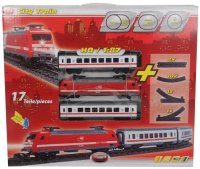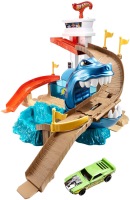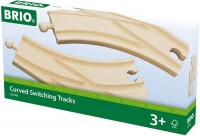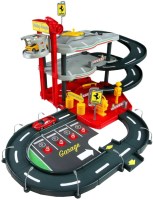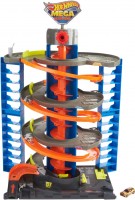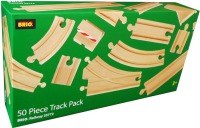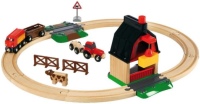Car & Train Tracks BRIO
You might be interested in
Car & Train Tracks: specifications, types
Type
— Auto track. Autotracks are called toy tracks for launching cars. Usually, the track itself looks like a chute with sides that do not allow the machine to roll out of the track. The design of autotracks can vary from the simplest straights and circuits to complex routes with multiple levels or stunts (see "Track Shape"). Also note that in most cases cars can be played off the track.
— Railroad. “Toy railroad” sets, including locomotives, wagons, rails along which it all moves, and often also additional equipment (semaphores, crossings, stations, etc.). However, specific configuration options can be very diverse: in particular, in addition to independent kits, you can find on the market kits for expanding an existing railway (for example, separately sold rails or a locomotive).
— Railroad. “Toy railroad” sets, including locomotives, wagons, rails along which it all moves, and often also additional equipment (semaphores, crossings, stations, etc.). However, specific configuration options can be very diverse: in particular, in addition to independent kits, you can find on the market kits for expanding an existing railway (for example, separately sold rails or a locomotive).
Age
The minimum age of the child for which the kit is designed.
Of course, this parameter is quite approximate, but it is still not recommended to deviate from it: a set that is too “adult” may turn out to be too complicated and even dangerous for a child (for example, small children tend to put various objects into their mouths, and toys with small details highly undesirable for them).
Now on the market there are kits for children of different ages: from 1 year old, 2+, 3+, 4+, 5+, 6+, 8+.
Of course, this parameter is quite approximate, but it is still not recommended to deviate from it: a set that is too “adult” may turn out to be too complicated and even dangerous for a child (for example, small children tend to put various objects into their mouths, and toys with small details highly undesirable for them).
Now on the market there are kits for children of different ages: from 1 year old, 2+, 3+, 4+, 5+, 6+, 8+.
Scale
The scale at which the car track or railway is made.
This indicator describes how many times the set items are smaller than real cars or trains; for example, 1:72 means a reduction of 72 times. Accordingly, the larger the number in the denominator, the smaller the scale and the smaller the individual elements of the set will be.
This indicator describes how many times the set items are smaller than real cars or trains; for example, 1:72 means a reduction of 72 times. Accordingly, the larger the number in the denominator, the smaller the scale and the smaller the individual elements of the set will be.
Track shape
The general shape of the autotrack track (see "Type"). Note that many traces allow a change in shape due to the rearrangement of individual sections; for such cases, the most complex shape that can be assembled from the elements of a set is taken into account — for example, a track assembled in the form of a figure eight or a ring belongs to the "eights". Specific form options may be as follows:
— Direct. Routes of the simplest direct form; may have ups and downs, but when viewed from above, the shape of such a track still turns out to be straight. Note that in addition to independent tracks, this category may also include accessories designed to complement existing sets.
— Ring. Tracks without acrobatic elements, closed in a ring; usually have an oval shape. The simplest kind of tracks that allow you to arrange "endless" races are races with numerous laps.
— Eight. A kind of circular tracks, closed in the form of a figure eight. This shape allows you to increase the length of the track without a significant increase in its overall dimensions. Also in this category are tracks in the form of a double eight, with four roundings — "petals".
— Trick. Tracks designed to perform various tricks: loops, jumps, etc. Can have a custom design that allows you to change the or...der of tricks at the discretion of the players. There are both straight and looped stunt tracks
— Multilevel. Tracks that have several "floors" with transitions between them. Note that there may be elevation differences on other types of tracks, in particular, stunt ones; however, in this case, it is precisely the presence of full-fledged levels that is implied — horizontal sections at different heights, between which cars can move. Among other things, such kits can be made in the form of multi-storey car parks.
— Direct. Routes of the simplest direct form; may have ups and downs, but when viewed from above, the shape of such a track still turns out to be straight. Note that in addition to independent tracks, this category may also include accessories designed to complement existing sets.
— Ring. Tracks without acrobatic elements, closed in a ring; usually have an oval shape. The simplest kind of tracks that allow you to arrange "endless" races are races with numerous laps.
— Eight. A kind of circular tracks, closed in the form of a figure eight. This shape allows you to increase the length of the track without a significant increase in its overall dimensions. Also in this category are tracks in the form of a double eight, with four roundings — "petals".
— Trick. Tracks designed to perform various tricks: loops, jumps, etc. Can have a custom design that allows you to change the or...der of tricks at the discretion of the players. There are both straight and looped stunt tracks
— Multilevel. Tracks that have several "floors" with transitions between them. Note that there may be elevation differences on other types of tracks, in particular, stunt ones; however, in this case, it is precisely the presence of full-fledged levels that is implied — horizontal sections at different heights, between which cars can move. Among other things, such kits can be made in the form of multi-storey car parks.
Number of cars
The number of cars included in the delivery set of the car track (see "Type"). Note that some manufacturers produce cars for their tracks separately, so if you wish, you can buy them in addition to the existing set. However, the number of cars often adjusts to the features of the track — in particular, the number of lanes.
Launching cars
The launch method provided for in the design. This parameter is indicated for auto tracks (see “Type”).
- Launcher. Start using a mechanical system, which most often resembles a catapult in its operating principle: to start, you need to sharply press or hit a special button, the mechanism will give the machine a “kick” and set it in motion.
— Speed controller. In this case, we mean a wired machine control panel; it may provide for speed adjustment, but there are tracks where the remote control serves only as a switch and the speed of the cars is not adjustable. Cars in such sets move along special guides, from which they receive power for movement.
— Manual generator. Electrically powered tracks, in which each car receives electricity from its own manual generator. Such kits have two interesting features. Firstly, they do not require batteries: the electricity needed for movement is generated by turning the generator handle. Secondly, by changing the speed of rotation of the handle, you can change the speed of the machine. This is very convenient for competitions: the one who manages the generator more competently wins, ensuring maximum speed and at the same time not allowing the car to fly off the track. Therefore, tracks with this feature are usually two-lane (see “Amount of lanes”), and the cars in them move along...special guides through which power is supplied to them.
— Inertial. Starting using an inertial mechanism installed in the machine itself. Such a mechanism is essentially an accumulator of kinetic energy; Such a battery is usually “charged” by pulling the car back, after which it is enough to release it - and the inertial mechanism will give the car a powerful push, allowing it to go the entire route at once. The inertial principle of operation is found mainly in stunt tracks (see “Track shape”).
- Motion Sensor. A rather unusual way to start and control: the machine is equipped with an electric motor and a built-in sensor that can track the user’s movements. To start moving, you need to wave your hand over the sensor, and the faster you wave, the higher the speed. The motion sensor is convenient because it allows you to do without unnecessary remote controls and wires; it requires certain “extra movements”, but this is usually not a problem for children, who for the most part are already energetic and restless.
— Electric motor. As a rule, in this case we mean an electric motor installed directly into the car, although there are also more specific options (such as a mechanism with a pair of rotating rollers installed on the track and giving an impulse to the car every time it passes through it). Note that the built-in electric motor is often powered not by batteries, but by a supercapacitor, and before starting to move, the machine must be installed on a charger in order to accumulate energy in the supercapacitor.
— Barrier. In this case, a barrier is a device that blocks a highway and opens at the press of a button or lever. This type of start is used mainly in stunt tracks, where the car gains acceleration while rolling down an inclined slope. The start is located at the beginning of the descent, and a special stopper blocks the road, preventing the car from sliding down, and when the barrier is “opened,” this stopper is removed and the car rolls down the hill freely. - Manual. The auto track does not have any special mechanism for starting and moving: you need to move the cars exclusively with your hands. This option is found mainly in sets for the younger age category, which are designed for the most simple games.
- Launcher. Start using a mechanical system, which most often resembles a catapult in its operating principle: to start, you need to sharply press or hit a special button, the mechanism will give the machine a “kick” and set it in motion.
— Speed controller. In this case, we mean a wired machine control panel; it may provide for speed adjustment, but there are tracks where the remote control serves only as a switch and the speed of the cars is not adjustable. Cars in such sets move along special guides, from which they receive power for movement.
— Manual generator. Electrically powered tracks, in which each car receives electricity from its own manual generator. Such kits have two interesting features. Firstly, they do not require batteries: the electricity needed for movement is generated by turning the generator handle. Secondly, by changing the speed of rotation of the handle, you can change the speed of the machine. This is very convenient for competitions: the one who manages the generator more competently wins, ensuring maximum speed and at the same time not allowing the car to fly off the track. Therefore, tracks with this feature are usually two-lane (see “Amount of lanes”), and the cars in them move along...special guides through which power is supplied to them.
— Inertial. Starting using an inertial mechanism installed in the machine itself. Such a mechanism is essentially an accumulator of kinetic energy; Such a battery is usually “charged” by pulling the car back, after which it is enough to release it - and the inertial mechanism will give the car a powerful push, allowing it to go the entire route at once. The inertial principle of operation is found mainly in stunt tracks (see “Track shape”).
- Motion Sensor. A rather unusual way to start and control: the machine is equipped with an electric motor and a built-in sensor that can track the user’s movements. To start moving, you need to wave your hand over the sensor, and the faster you wave, the higher the speed. The motion sensor is convenient because it allows you to do without unnecessary remote controls and wires; it requires certain “extra movements”, but this is usually not a problem for children, who for the most part are already energetic and restless.
— Electric motor. As a rule, in this case we mean an electric motor installed directly into the car, although there are also more specific options (such as a mechanism with a pair of rotating rollers installed on the track and giving an impulse to the car every time it passes through it). Note that the built-in electric motor is often powered not by batteries, but by a supercapacitor, and before starting to move, the machine must be installed on a charger in order to accumulate energy in the supercapacitor.
— Barrier. In this case, a barrier is a device that blocks a highway and opens at the press of a button or lever. This type of start is used mainly in stunt tracks, where the car gains acceleration while rolling down an inclined slope. The start is located at the beginning of the descent, and a special stopper blocks the road, preventing the car from sliding down, and when the barrier is “opened,” this stopper is removed and the car rolls down the hill freely. - Manual. The auto track does not have any special mechanism for starting and moving: you need to move the cars exclusively with your hands. This option is found mainly in sets for the younger age category, which are designed for the most simple games.
Track length
The total length of the car track (see "Type"); for rings and eights, the length of the circle is indicated, respectively.
The longer the track, the more advanced the car track is, other things being equal; on the other hand, a large length directly affects the dimensions of the structure and the cost of the set. It is also worth noting that some manufacturers produce add-on kits designed to expand existing tracks.
The longer the track, the more advanced the car track is, other things being equal; on the other hand, a large length directly affects the dimensions of the structure and the cost of the set. It is also worth noting that some manufacturers produce add-on kits designed to expand existing tracks.
Number of lanes
The number of lanes for traffic provided in the design of the car track (see "Type"). In addition to single-lane, there are also two-lane tracks: they allow you to run two cars at the same time, including for competitions.
Lap counter
The presence in the autotrack (see "Type") built-in counter, counting the circles passed by each machine.
This feature is only found on two-lane courses (see "Number of lanes") used for competitions: determining the number of laps without a metre can be difficult, but the metre provides accurate readings and eliminates the need to count laps yourself.
This feature is only found on two-lane courses (see "Number of lanes") used for competitions: determining the number of laps without a metre can be difficult, but the metre provides accurate readings and eliminates the need to count laps yourself.
Track style
General railroad style (see "Type")
— Passenger. Sets that replicate passenger trains - from city trains to high-speed express trains
— Cargo. Sets that replicate freight (goods) trains. They differ in variety: if on a passenger train the cars have the same design, then on a freight train there may be cars of different types.
- Retro. Sets replicating vintage trains, often with steam locomotives as locomotives.
- Children's. Railways designed for younger children. They are made in a characteristic bright design, are distinguished by their simplicity of design, and the tracks often have a specific structure: instead of rails, train wheels roll along furrows-ruts. This device simplifies the installation of “equipment” on the rails and minimizes the likelihood that it will go off the tracks.
— Passenger. Sets that replicate passenger trains - from city trains to high-speed express trains
— Cargo. Sets that replicate freight (goods) trains. They differ in variety: if on a passenger train the cars have the same design, then on a freight train there may be cars of different types.
- Retro. Sets replicating vintage trains, often with steam locomotives as locomotives.
- Children's. Railways designed for younger children. They are made in a characteristic bright design, are distinguished by their simplicity of design, and the tracks often have a specific structure: instead of rails, train wheels roll along furrows-ruts. This device simplifies the installation of “equipment” on the rails and minimizes the likelihood that it will go off the tracks.
Number of locomotives
The number of locomotives supplied with the railway (see "Type").
Many children's railways are equipped with just one locomotive, enough to run the train. However, there are also exceptions. So, there are quite a few "tyanitolkaev" trains that have two locomotives, from both ends of the train; in such trains it is possible to switch from one locomotive to another by swapping "head" and "tail" and running the train in the opposite direction. Three locomotives in a set can mean either three separate trains or a regular train plus a "pull". And four locomotives usually correspond to two pushers.
It should be noted that mainly children's railways are equipped with several trains (see "Road style").
Many children's railways are equipped with just one locomotive, enough to run the train. However, there are also exceptions. So, there are quite a few "tyanitolkaev" trains that have two locomotives, from both ends of the train; in such trains it is possible to switch from one locomotive to another by swapping "head" and "tail" and running the train in the opposite direction. Three locomotives in a set can mean either three separate trains or a regular train plus a "pull". And four locomotives usually correspond to two pushers.
It should be noted that mainly children's railways are equipped with several trains (see "Road style").
Number of carriages
The number of carriages provided for in the railway (see "Type").
The number of carriages is selected taking into account the scale and length of the railway, so that the train does not take up too much space on the tracks. In the most extensive sets, up to ten wagons can be provided. And some manufacturers provide the possibility, if desired, to purchase additional wagons to the existing set.
The number of carriages is selected taking into account the scale and length of the railway, so that the train does not take up too much space on the tracks. In the most extensive sets, up to ten wagons can be provided. And some manufacturers provide the possibility, if desired, to purchase additional wagons to the existing set.
Track length
The total length of the track of the railway (see "Type").
The longer the length, the more advanced the set is, the more opportunities for games it gives. On the other hand, a large length directly affects the cost and dimensions.
The longer the length, the more advanced the set is, the more opportunities for games it gives. On the other hand, a large length directly affects the cost and dimensions.
Number of track details
The number of individual track parts included in the railroad delivery set (see "Type").
Details in this case mean the individual segments that make up the railway. In the most extensive sets, this number can be several dozen. In general, this parameter is mainly for reference, but it also has a practical meaning: the more details, the more “freedom of action” the player has when building a track, the more options for building tracks of various shapes, complexity and duration.
Details in this case mean the individual segments that make up the railway. In the most extensive sets, this number can be several dozen. In general, this parameter is mainly for reference, but it also has a practical meaning: the more details, the more “freedom of action” the player has when building a track, the more options for building tracks of various shapes, complexity and duration.
Track
Gauge in the railway (see "Type").
The larger the gauge, the larger the scale in which the set is made, the larger the locomotives and wagons. In addition, this information may be useful when purchasing additional locomotives and wagons: for normal use, they must have the same gauge as the existing rails.
The larger the gauge, the larger the scale in which the set is made, the larger the locomotives and wagons. In addition, this information may be useful when purchasing additional locomotives and wagons: for normal use, they must have the same gauge as the existing rails.
Effects
Additional effects provided in the autotrack or railroad (see "Type").
— Light. Various lighting effects: headlights of cars and locomotives, taillights of wagons, light in windows, street lights, etc.
— Sound. Various sound effects: engine roar, horn, wheels clattering at the joints, locomotive “chuffing”, beeps, musical accompaniment, etc.
— Smoke. Imitation of smoke from a chimney. It is found exclusively in railways, namely in sets with steam locomotives — after all, among locomotives, it is steam locomotives that smoke the most. To create "smoke", a steam generator is usually used, filled with water or a special liquid; such "smoke" is odorless and harmless to others.
— Light. Various lighting effects: headlights of cars and locomotives, taillights of wagons, light in windows, street lights, etc.
— Sound. Various sound effects: engine roar, horn, wheels clattering at the joints, locomotive “chuffing”, beeps, musical accompaniment, etc.
— Smoke. Imitation of smoke from a chimney. It is found exclusively in railways, namely in sets with steam locomotives — after all, among locomotives, it is steam locomotives that smoke the most. To create "smoke", a steam generator is usually used, filled with water or a special liquid; such "smoke" is odorless and harmless to others.
Remote control
The presence of a remote control in the set.
The meaning of this function is generally obvious, we note only one point: do not confuse the remote control with the speed controller (see "Starting the cars"), these are different devices. First, the remote control is usually made wireless; secondly, it is provided mainly in railways, and is rare among autotracks.
The meaning of this function is generally obvious, we note only one point: do not confuse the remote control with the speed controller (see "Starting the cars"), these are different devices. First, the remote control is usually made wireless; secondly, it is provided mainly in railways, and is rare among autotracks.
Power source
The type of food provided in the kit.
Most kits use classic replaceable batteries of standard sizes — most often AA (“finger”) or AAA (“little finger”), however, in some cases, larger cells like C or D may be required. In addition, there are kits that use several types at once batteries — for example, AA for the movement of a locomotive and AAA for lighting effects in cars.
Most kits use classic replaceable batteries of standard sizes — most often AA (“finger”) or AAA (“little finger”), however, in some cases, larger cells like C or D may be required. In addition, there are kits that use several types at once batteries — for example, AA for the movement of a locomotive and AAA for lighting effects in cars.
Material
The main material used in the construction of the set.
— Plastic. Plastic is extremely popular as a material for toys, including autotracks and children's railways. This material is relatively inexpensive, easy to process, can be of any colour and coloring, and is suitable for even the most complex shapes.
— Tree. For a number of reasons, wood is used primarily in children's railways (see "Road/Railway Style"). This is a fairly practical material — in particular, wooden parts are usually made solid and have a fairly large thickness, thanks to which they are well resistant to bumps, falls and other "tests" that a curious little child can subject them to. In addition, wood is appreciated by lovers of natural materials (although in this case its naturalness is rather arbitrary, since wooden surfaces are painted and variously impregnated).
— Metal. The metal is mainly used in advanced railways (see "Type"), which replicate real trains in detail. From a practical point of view, this material is distinguished, on the one hand, by its strength, and, on the other hand, by a relatively high cost. In addition, it is easier to cut yourself on a small metal part than on a plastic or wooden one, so metal sets are designed mainly for older children.
— Plastic. Plastic is extremely popular as a material for toys, including autotracks and children's railways. This material is relatively inexpensive, easy to process, can be of any colour and coloring, and is suitable for even the most complex shapes.
— Tree. For a number of reasons, wood is used primarily in children's railways (see "Road/Railway Style"). This is a fairly practical material — in particular, wooden parts are usually made solid and have a fairly large thickness, thanks to which they are well resistant to bumps, falls and other "tests" that a curious little child can subject them to. In addition, wood is appreciated by lovers of natural materials (although in this case its naturalness is rather arbitrary, since wooden surfaces are painted and variously impregnated).
— Metal. The metal is mainly used in advanced railways (see "Type"), which replicate real trains in detail. From a practical point of view, this material is distinguished, on the one hand, by its strength, and, on the other hand, by a relatively high cost. In addition, it is easier to cut yourself on a small metal part than on a plastic or wooden one, so metal sets are designed mainly for older children.


